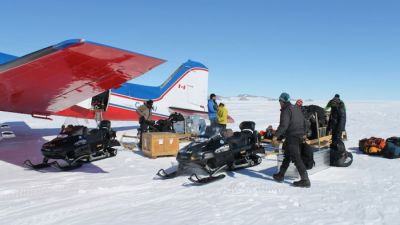
Season’s First Science Teams Arrive at Princess Elisabeth Antarctica
Just before the weekend, the first nine scientists of the summer season, from Belgium, UK, Japan and Germany, were welcomed to Princess Elisabeth Antarctica by expedition leader Alain Hubert and the rest of International Polar Foundation team.
Six of the scientists are here to work on the IceCon project, headed by up Frank Pattyn. They’re aiming to get a better understanding of the rate of the loss of ice - now and in the past - from the ice sheet in the Dronning Maud Land region. By investigating a “meltwater pulse” from 14,000 years ago, which caused sea levels to rise 20m within 500 years, they hope to use its effect on oceanography and climate as a potential analogue for current and future rapid ice sheet loss.
IceCon is comprised of six partners from Belgian and foreign institutions: Université Libre de Bruxelles (ULB), Royal Observatory of Belgium (ROB), University of Luxembourg (UL), Norwegian Polar Institute (NPI), and Aberystwyth University (AU). The IceCon team in Antarctica is: Frank Pattyn, Jean Louis Tison and Morgane Philippe from Université Libre de Bruxelles, Nicolas Bergeot of the Royal Observatory of Belgium, Bryn Hubbard from Aberystwyth University in the UK, and Kenichi Matsuoka Norwegian Polar Institute. Read more about IceCon.
German glaciologist Reinhard Drews, from Université Libre de Bruxelles, is also now at Princess Elisabeth Antarctica, where he will start fieldwork on his Be:Wise project. Reinhard received the prestigious €150,000 InBev Baillet Latour Antarctic Fellowship in October, for his plan to investigate how the potential disintegration of Antarctic floating ice shelves could contribute to increased ice flow from inland glaciers, and a resulting rise in global sea levels [4]. Reinhard is joined by Denis Callens (from the Université Libre de Bruxelles.
Then there’s veteran Princess Elisabeth Antarctica researcher, Alexander Mangold, from the Royal Observatory of Belgium, who is at Princess Elisabeth Antarctica for a fourth season, to continue the BELATMOS project, the objective of which is to carry out observations on the composition and chemistry of the atmosphere in the vicinity of the station.
During the rest of the 2012-2013 BELARE season, Princess Elisabeth Antarctica will host some 30 scientists in total working in the fields of atmospheric science, glaciology, meteorology, geology, and microbiology, from several different countries, including large campaigns from Belgium, Germany and Japan.
2012-2013 BELARE Research Projects include:
- BELATMOS - Ozone, UV radiation and aerosols - Belgian Royal Meteorological Institute (RMI), Dr. Alexander Mangold
- ICECON: Understanding ice dynamics – led by the Université Libre de Bruxelles (ULB)
- BELDIVA: Exploration of microbiology diversity – Satoshi Imura, National Institute of Polar Research (NIPR), Japan
- GIANT-LISSA: Dr Olivier Francis, University of Luxembourg will install an absolute gravimeter
- GEAII: Polar 6 airborne survey, Alfred Wegener Institute (Germany)
- SAMBA: Meteorite search on the Nansen Icefields, Vrije Universiteit Brussel (VUB), ULB, and NIPR.
- LGGE: Surface mass balance observations carried out by the International Polar Fondation on behalf of Grenoble-based Laboratoire de Glaciologie et Géophysique de l'Environnement (LGGE), France
- Micrometa: Search for microscopic extraterrestrial dust (VUB)
- BE:WISE: Research on buttressing effects on ice shelves (ULB)
Picture: International Polar Foundation team arrives in Antarctica - © International Polar Foundation/Alain Hubert
